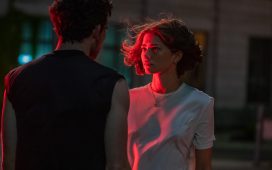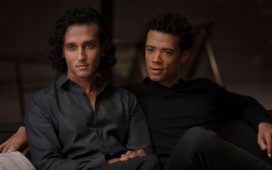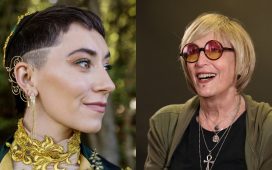The narrator of Eliza Barry Callahan’s “The Hearing Test” is an artist in her late twenties named Eliza who lives in New York City. She wakes up one morning in August with a buzz in her ear that’s accompanied by the sound of “perpetually rolling thunder.” “It’s like God adjusting his piano stool but never getting around to the song,” she says. Her dog’s bark is “distorted and distant.” Her own voice sounds unfamiliar, the volume “dialed up and the pitch . . . shifted.” She’s supposed to board a plane to Venice that afternoon—her friend is getting married—so she rushes to an emergency clinic, where a nurse praises the cleanliness of her ears and a doctor administers a hearing test. Afterward, he announces, cryptically, “Bad luck.” The words have the ring of a diagnosis.
Eliza has come down with a medical ailment called sudden sensorineural hearing loss, or sudden deafness for short. “The Hearing Test” loosely tracks the next year in her life. Experts warn that her condition is unlikely to get any better and could get worse; Eliza starts to prepare “for everything to be the quietest version of itself before disappearing altogether, in a cloak of itself.” As the symphony of the world softens, her own body gets louder. “When I blinked,” she reports, “I could hear my eyelids meeting—dull and dense like a head hitting the pillow.”
Like a lot of autofiction, the book monitors the daily routine of a solitary narrator in an urban milieu. Callahan writes suggestively about how a sick ear might translate sound. (“The street was in my kitchen—the hum of passing cars was now coming from somewhere near my stove and sounded like bees.”) Her main focus, though, is on Eliza’s generalized depression, anger, and fear. Eliza goes to doctors’ appointments, shops for groceries, works with a hypnotherapist over Zoom, sees friends, stays with her ex and his new girlfriend in Los Angeles, travels with her mother to Europe, and thinks about art, particularly by blind or deaf artists. Undercurrents of financial anxiety and financial reprieve tangle throughout: although many of her doctors waive their fees because of the unusual nature of her case, she has no income and is running down her savings.
Eliza’s emotions develop a muffled quality. During one hypnotherapy session, she wonders how “it was possible that I could be experiencing such extreme degrees of fear and boredom at once.” Her interactions with others—a friend who sends back her paella and complains about her narcissistic mother; a painter “whose subject was primarily herself”; a stranger at the market who takes the piece of fish that Eliza was eying—shimmer with suppressed hostility. I thought of the outwardly dispassionate but sharply motivated observations of Rachel Cusk in her “Outline” trilogy, a clear influence here. In a way that echoes Cusk’s writing, Eliza’s descriptions and judgments about her surroundings throw her inner life into relief: they seem designed to direct attention to how her mind moves. Callahan also shares Cusk’s flair for seeding strange and piquant details into the speech of her narrator’s interlocutors. One of Eliza’s neighbors “said her storage unit was just a mausoleum for her two Italian greyhounds—named S and M—who had died within days of each other. . . . When the dogs had played, she said, they would chase each other in circles and often become one beautiful silver sphere that looked like it was floating.”
In “Outline,” the narrator’s divorce only gradually emerges as the novel’s central subject—the source of the book’s free-floating disaffection. The origins of Eliza’s sadness and anger are similarly oblique in “The Hearing Test.” Deafness might explain it, but so might Eliza’s relationship with her ex, a filmmaker who continues to desultorily pursue her even after he moves across the country for another woman. We get only snippets of interaction between the former lovers and almost none of their backstory, but what we do know is damning. Eliza’s ex talks past her and criticizes her for small things. He invites her to a gallery and, after she shows up thirty minutes late, claims that he has to leave soon, prompting her to reflect that, although “I had always considered myself to be a respectful person,” he “had historically made me feel like a disrespectful person.”
Callahan’s writing emits the most heat in these scenes of romantic malaise, in which the filmmaker works on Eliza’s perceptions and psyche almost as deafness does: both seem to produce a sort of poetic alienation, a sensitivity that tips over into numbness. In a Cusk-like home-renovation metaphor, Eliza compares her ex to “a termite that finds its way inside the walls of a house. And the termite, like a perfect houseguest, has a sense when it’s stayed just long enough. Just long enough to have pushed the house to its absolute brink. Then it goes and leaves the house empty, eroded. I had once loved him.”
Heartbreak and hearing loss are either symbols for each other or paired expressions of something deeper: a fundamental out-of-tune-ness that is beguilingly present in Callahan’s style. Eliza’s voice sounds, at first listen, slightly discordant, slightly wrong. “I have a habit, since I can remember, of reading plot summaries of movies and books before watching or reading them,” she says, when introducing herself. The repetition of “reading” and the faint awkwardness of “since I can remember” have a back-footing effect, hinting at elements lost in translation. Elsewhere, Callahan’s synesthetic language troubles the distinctions between senses. Frequent ellipses represent sound trailing off (“I always seem to begin things late at night . . .”), and the narrator’s thoughts can follow a punning, playful logic. The name of her audiologist, Robert Walther, leads her to meditate on the artist Robert Walser; songs circling a room are audio “flies, the living anagram of files.” Her summaries of other people’s speech proliferate non sequiturs—is it because the people she talks to don’t connect their thoughts, or because she can only make out every other sentence? “The Hearing Test” can feel like a book made out of dropped calls, grainy images, and shut doors. As her hearing worsens, Eliza says, “the presence of things made me more aware of the way I was experiencing their absence.”
Callahan is interested in the accidental meanings that arise from errors. What forms of understanding are possible, she asks, when you subtract or garble various senses, various modes of knowing? Mild spoiler: Eliza’s deafness goes into remission near the end of the year. This gives her tryst with silence a bounded quality and allows Callahan to treat it poetically, as a break from everyday life, rather than logistically, as the beginning of a process of learning to navigate the world anew. Eliza wonders about people’s motives and behavior. She thinks about the impenetrability of minds, landscapes, and dreams. For Callahan, who sprinkles the book with flashbacks from before Eliza’s diagnosis, deafness is both a medical condition and a metaphor for the incompleteness of our knowledge of the world. Even as a child, Eliza says, she was prone to misconstruals: when her French teacher, who spoke with a heavy accent, referred to the “apostles” on the roof of Notre Dame, she thought the lesson was about “apple sauce.” The book implies that, because our senses lie, ambiguity and mystery indicate a nearness to the truth. In Eliza’s case, the unknowability of reality leads to a further turn inward: maybe the most honest way to understand a life in which you are doomed to get things wrong is to deliberately misinterpret. Eliza, struggling to follow her ex-boyfriend’s speechifying, lets her thoughts drift across what he might or might not be saying, observing the way that her imagination fills in the gaps. “Our misinterpretations,” she proposes, might be “the most individual and specific things we have.”
At times, Callahan seems to privilege the metaphor of sensory deprivation over the concrete reality of hearing loss. In one of the novel’s most breathtakingly crafted passages, Eliza finds herself in a threesome:







